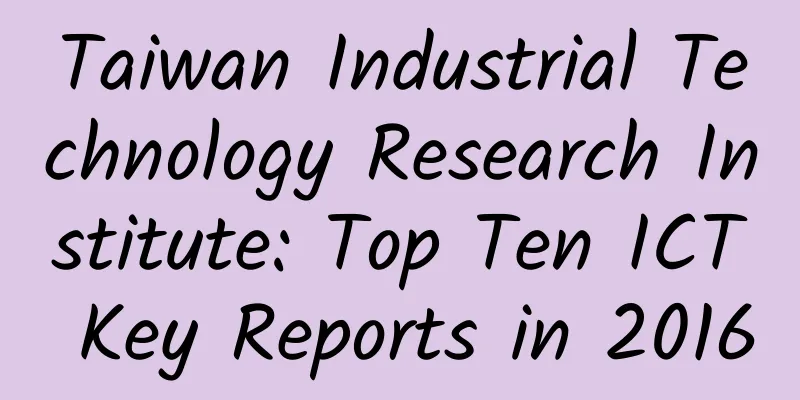Taiwan Industrial Technology Research Institute: Top Ten ICT Key Reports in 2016

|
ITRI proposes the top ten key ICT industry topics every year. This year's "top ten key ICT industry topics" include: diversified innovation vehicles and diversified markets, collaborative sharing, online audio and video, IoT security, network virtualization, spectrum allocation, vertical integration, automotive semiconductors, machine learning and machine vision, etc., all of which will bring more drastic changes to the ICT industry. Looking back at the main themes of the past three years, from "Intelligence is everywhere" in 2014, "Starting IoT applications" in 2015, to this year's "Big Mesh! Diverse vehicles, the rise of heroes", it shows that the ICT industry is entering a diversified development. Four mobile vehicle products launched simultaneously, achieving rapid growth In early 2016, Google's market value once again surpassed Apple's, indicating that Google's path of diversified development in collaboration with global hardware manufacturers is clearly in the right direction. This also means that innovative vehicles will continue to move forward in the future, prompting the ICT industry to accelerate its development in a bullish direction. In 2015, the Internet of Things era officially arrived. Ubiquitous computing sensors have formed a multi-dimensional intelligent space. From 2016 to 2020, the global ICT industry will enter the era of intelligent machines. Therefore, artificial intelligence will be fully popularized, including unmanned vehicles, drones, robots and other machines that can make independent judgments and learn. It is estimated that from 2016 to 2020, the global market compound annual growth rate (CAGR) of the four major innovative vehicles, VR wearable devices, unmanned vehicles, drones and intelligent robots, will reach 115%, 134%, 38.3% and 10.7% respectively, all of which will grow rapidly. In addition, the exhibition area for traditional computing and mobile devices at this year's Consumer Electronics Show (CES) in the United States has been reduced, while the exhibition area for manufacturers of wearable devices, smart cars, drones, etc. has increased significantly. It can be seen that the focus of ICT industry development has shifted from smart mobile devices to various innovative vehicles. The rise of the sharing economy creates new services Since 2015, the collaborative sharing economy has swept the world, driving innovative services and the innovative economy, accelerating the subversion of the traditional supply and demand value chain model, and gradually forming a new industrial ecological chain. The global collaborative sharing business model has many characteristics, namely: small quantity, variety, customization, P2P horizontal production integration, shortened supply chain, decentralized management of corporate operations, zero marginal cost benefits, floating prices, and emphasis on the value of shared and reusable goods. For example, Uber, Airbnb, LendingClub, etc. all have these characteristics. Disruptive innovative businesses have made these companies' market values exceed tens of billions of dollars and have been rapidly replicated in the global market, giving rise to innovative collaborative business services such as vehicle rental or ridesharing, accommodation services, logistics and express delivery, manpower support, and housework management. The key technology behind the successful business model of collaborative sharing is the core foundation for expanding the market scale, derivative applications and sustainable operation. In addition, the development of collaborative sharing platforms is also very important. IEK estimates that there will be more than 10,000 collaborative sharing platforms in the world in 2016, with an annual growth rate of 25%. Online video and audio media mobile live broadcast is very popular According to IEK data, the global penetration rate of smart connected devices continues to rise. Between 2013 and 2014, online advertising in the US and mainland China markets surpassed television advertising and became mainstream media. It is estimated that in 2016, Taiwan's new media advertising, including mobile and online, will reach NT$32.08 billion, higher than the NT$25.41 billion in television advertising for cable and wireless television, indicating that new media will become the largest advertising market in Taiwan and become mainstream media. As the number of 4G users continues to increase, smart mobile devices will enable faster and better video viewing experiences, and will be able to provide real-time online live broadcasts, interactive features and other functions, providing consumers with an excellent viewing experience. This will lead to the rapid rise of mobile video and the accelerated development of emerging OTT operators. At the same time, video service providers such as TV stations and content providers are threatened in the traditional TV market and are rapidly turning to new media development. IEK predicts that in 2016, the application market for emerging online video services, including live interactive broadcasts and video-triggered online shopping, will continue to expand. In order to win the video business opportunities in the future, it is necessary to master the two main axes of "creating experience" and "mastering data". Internet-connected devices interoperate and security becomes a new challenge With the booming development of the sharing economy, online video and the Internet of Things industry, information security is becoming increasingly important. In 2014, global IoT-related open alliances were established one after another, such as Intel, Samsung, and Dell, which led the establishment of the Open Interconnect Consortium (OIC), which brought great impetus to the entire industry. In addition, Apple released HomeKit, chip giant ARM released mbed OS, and Google released Brillo in 2015, all of which showed that the integration of IoT device communication protocols is an inevitable trend. As major companies establish data interoperability mechanisms, the difficulty of protecting information security is increasing, and they are all actively working on this. In 2015, ARM acquired Offspark and integrated its embedded transport layer security (TLS) technology into mbed OS to make up for the shortcomings of its Cryptobox technology in secure execution and storage. According to a report published by Garnter, the number of IoT devices will increase to more than 25 trillion by 2020, but the security mechanisms of most devices are still insufficient. IEK pointed out that in 2015, the amount of losses caused by hacking and fraud in non-cash payment systems including cards, checks, and automated clearing houses reached US$16 billion. Virtual networks are the new trend, and huge business opportunities are emerging Network virtualization will be one of the most important topics in 2016. In response to the advent of the cloud, Internet of Things and big data era, traditional telecom operators have stepped up their deployment of open innovation-based network function virtualization (NFV) technology, including well-known telecom operators such as AT&T and Verizon in the United States, British Telecom (BT) and NTT Communications in Japan, all of which are actively engaged in NFV network trials to save deployment and maintenance costs and accelerate service time to market. The vigorous promotion of NFV by international operators will have an impact on the entire network ecosystem, thereby triggering related business opportunities. IEK estimates that in 2016, there will be larger-scale NFV niche deployments, including NFV hardware, software and service output value will reach US$3.45 billion, with an annual compound growth rate of 49.8%. The output value will grow fivefold in 2019, and operators' investment in software will be greater than that in hardware equipment such as servers, storage and switches. IEK analyzed that at this stage, NFV technology is promoted in the form of open source, which drives the development of NFV in multiple directions, including: the network environment is open and the hardware and software are decentralized. Drones will take off as spectrum allocation is finalized At the World Radiocommunication Conference (WRC-15) held in Geneva in November 2015, governments reached resolutions on spectrum allocation for mobile broadband communications, public safety and emergency communications), search and rescue, unmanned aerial vehicles and wireless avionics systems, road traffic safety, etc., which will help the development of future communication application services. The spectrum used for mobile broadband and PPDR planned by WRC-15 may overlap with the frequency bands that several IoT camps around the world want to adopt, which deserves close attention. IEK estimates that if the frequency bands below 1GHz can be widely used in various vertical markets and smart cities, it will bring equipment economies of scale. The WRC-15 resolution will help the legality of the use of unmanned aerial vehicles and drive the sales and development of unmanned aerial vehicles. On the issue of high frequency (above 6GHz), WRC-15 will also discuss the determination of frequency bands above 24GHz at the WRC-19 meeting three years later. In the next two years, high-frequency related issues will not have an immediate and obvious impact on the development of the industry. Machine learning technology is being used by major manufacturers The widespread application of machine learning technology will have a profound impact on the development of the next generation of technology. Google has been using machine learning technology for a long time, and products such as Gmail, Google Photo, Google Play, and even driverless cars have already introduced machine learning technology. In 2015, Google opened its own machine learning system Tensor Flow, providing free use and training of the algorithm, which will accelerate the advancement of machine learning technology. Other major companies have also opened up their machine learning platforms and acquired startups with machine learning technologies. It is foreseeable that the subsequent development of machine learning will be promising. In the future, machine learning will have a place in the development of the ICT industry, and Taiwan needs to formulate relevant strategies to cope with it. Since the development of machine learning technology is difficult, independent research and development may require long-term investment to achieve results. If the industry has sufficient funds, it can consider acquiring international technical teams. If the funds are insufficient, it can use foreign machine learning platforms. Self-developed chip semiconductors set off a trend IEK observed that in 2015 global chip supply statistics, the overall performance of IDMs (integrated device manufacturers) outperformed fabless IC design companies. This is the second time in the past 25 years. The key factor is that Samsung, a major IDM, abandoned Qualcomm products and switched to its own Exynos application processors, causing the revenue originally obtained by fabless IC companies to fall into the hands of IDMs, resulting in a year-on-year decrease of 17.4% in Qualcomm's revenue in 2015. This data shows that IoT applications are accelerating the trend of vertical integration, and system manufacturers are all actively strengthening their dominance in the chip field. In particular, Apple's successful model of developing mobile processors has made Apple's mobile processors account for a very important proportion of the overall revenue of wafer foundry, driving the trend of Samsung, LG, Huawei and Xiaomi to develop their own AP chips. The output value of Taiwan's semiconductor industry reached NT$2.3 trillion in 2015, an increase of 2.3%. However, as the global semiconductor ecosystem changes in the future, Taiwan's IC design industry will inevitably be affected as its products are mostly concentrated in the communications field. The market for ICs dedicated to automotive technology innovation is huge Among various emerging semiconductor applications, automotive electronics applications have the greatest potential. IEK estimates that the automotive electronics system market will grow at an average annual rate of about 6% from 2014 to 2019, and the market size will reach US$168 billion by 2019. As cars become more and more intelligent, the proportion of automotive electronics in the cost of a new car will increase, from 35% in 2010 to 50% in the future. The amount of semiconductor content in each car will also continue to rise, reaching US$610 by 2018. The automotive semiconductor market is growing rapidly. In addition to major automotive semiconductor manufacturers in the United States, Japan, and Europe, Intel, Samsung, Qualcomm, and nVidia have all launched dedicated automotive ICs to compete in the market in recent years. In addition, LG Electronics has also formed an alliance with General Motors to provide key components and modules for the Chevrolet Bolt electric car. Hyundai Motor will also make its own computer computing processing ICs and sensors for self-driving cars, showing the hot state of the market. Observing the development trend of automotive semiconductors, nine major car manufacturers launched the latest concept car models at the 2016 CES. In the future, cars will move towards intelligence, automation, electrification, and sharing. Image recognition is booming and its application scope is expanding In the field of components, the growth of machine vision technology and application market is the most promising. IEK pointed out that the image recognition technology based on optical images has been very popular recently. Apple, Microsoft, Intel, and Sony have acquired many head-mounted display-related image recognition manufacturers and continue to develop more advanced technologies, igniting the growth fuse of the machine vision market with special algorithms. IEK pointed out that machine vision can capture images and identify the type, shape, distance, movement direction, etc. of objects in the image. By integrating various sensors such as visible light, radar, laser, infrared, etc., combined with special algorithms, it can provide totem recognition, face recognition, gesture recognition, product detection, environmental exploration, etc., and realize intelligent application services. In the early days, machine vision was mostly used for optical inspection in factory automation. In recent years, its application scope has expanded to include self-driving cars, drones, robots, and AR/VR as the four main applications. ITRI IEK Profile The Industrial Technology Research Institute (ITRI) Industrial Economics and Trends Research Center (IEK) is one of the government's important think tanks, combined with ITRI's strong technical R&D support. IEK's new vision for 2020 is to become "an international think tank that leads Taiwan's industrial value creation", combining ITRI's advantages in technology industrialization, cross-domain and system integration, to propose and promote key issues in Taiwan's industrial and technological development, so as to leap forward national competitiveness and industrial added value. |
<<: CEO goes to heaven, where is Nintendo on earth headed?
>>: Survey shows that more than half of British companies want to set up IoT
Recommend
Meiyajia: Quickly and easily understand store operations [WeChat Enterprise Account Case]
Meiyijia Enterprise Account helps every store own...
New research finds: Eating more dark chocolate can reduce the risk of diabetes? The truth is...
Chocolate is delicious and loved by people, but a...
How to write World Cup copy? Here are some ready-made…
The World Cup is coming, how can copywriters scor...
Thought it was a heart attack but couldn't find the cause? This torturous disease turns out to be around us!
Expert of this article: Zhao Wei, MD, associate c...
Cancer is not scary. If you do these three things, you can "live with cancer". Please save this article.
With the advancement of modern medical technology...
QQ promotes QQ public account platform, things you must know!
Quietly, QQ launched the QQ public account platfo...
Advanced live broadcast room operation, save it now!
1. Live broadcast content planning Some students ...
Super detailed Tik Tok operation-tools!
All the practical information and skills are clos...
Electric Technology Car News: Can the Range Rover with stunning appearance, luxurious interior and super low price break through the competition from BMW and Porsche?
You may be unfamiliar with the Velar, but when yo...
Symptoms of the incubation period of novel coronavirus pneumonia. What are the symptoms of novel coronavirus pneumonia?
Pneumonia caused by the new coronavirus has attra...
Core competitiveness of APP promotion: A comprehensive collection of ASO strategies!
ASO , which is the abbreviation of App Store Opti...
In the wars of unification of ancient Chinese dynasties, why was Zhu Yuanzhang the only one who could unify China from south to north?
Although great unification was the mainstream and...
For bidding promotion, just read this article!
Today, based on years of experience in bidding pr...
Alibaba Cloud's glorious moment: Persisting in the long march of technology, CIPU redefines the global cloud computing system
In 1978, Intel ushered in decades of glory in the...
The first red warning for heavy rain this year! The "violent plum rain" in the middle and lower reaches of the Yangtze River continues to exert its force. How to prevent and avoid risks?
Just now, the Central Meteorological Observatory ...









